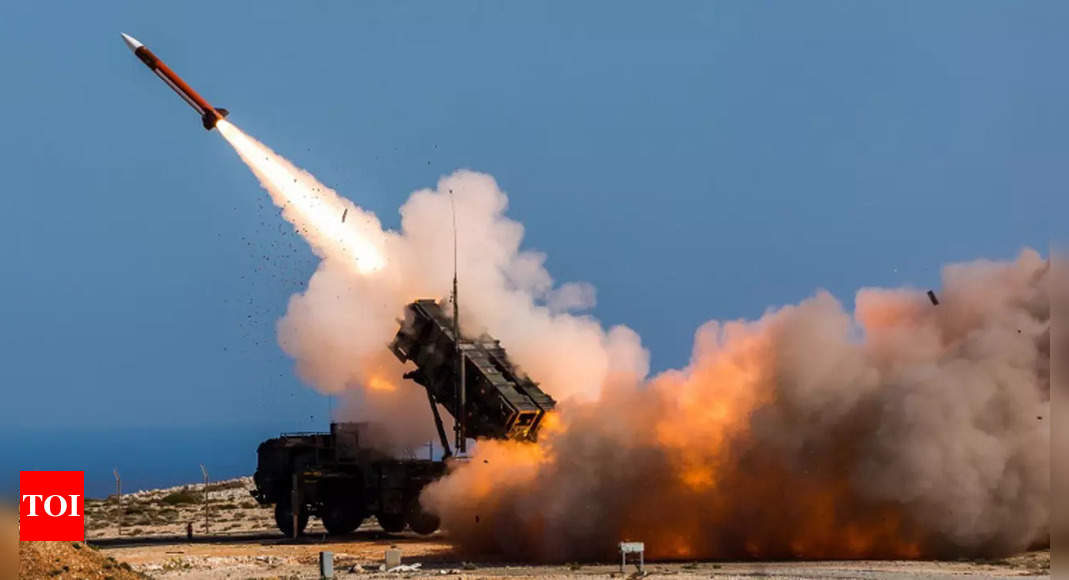[ad_1]
Desperate to meet Ukraine’s demands for everything from artillery shells to the Patriot missile defence system that the US is poised to provide, the Defence Department is tackling a decades-long bugbear that has plagued arms production: finding ways to speed up assembly lines and entice weapons-makers with longer-term contracts to show the US military won’t abandon a system once its immediate needs are met.
It’s also led to bigger questions about how the US supplies itself and allies for war. With Ukraine keeping up the pressure for more — and more advanced — arms, the US must confront the risk that its own stocks of some ground-based weapons will be depleted if it’s suddenly required to defend itself, help Taiwan defend against China or counter military action by North Korea.
The problem is especially acute because Russia is forcing Ukraine to wage a type of war that some Pentagon planners thought was a thing of the past. While the US has focused money and production on stealth fighter jets, AI-augmented goggles and hypersonic weapons, Ukraine wants artillery shells, tanks and shoulder-fired missiles to repel Russian ground assaults.
“This is a very serious challenge, both for Nato allies that are giving serious commitment, significant military assistance, lethal assistance to the Ukrainian military forces, but it is a significant challenge for the Ukrainian military forces themselves that are facing shortfalls,” Julianne Smith, the US ambassador to the North Atlantic Treaty Organization, said on December 13.
The numbers are staggering. As of Dec. 9, the US has committed to Ukraine more than 1 million 155mm artillery rounds, 180,000 105mm artillery rounds, more than 8,500 Javelin anti-tank missiles, 4,200 precision-guided Excalibur 155mm artillery rounds and 1,600 shoulder-mounted Stinger missiles.
Just-in-Time — Slowly
Just as the Coronavirus pandemic exposed the flaws in the world’s supply of everything from microchips to kitchen cabinets, the war in Ukraine and its military’s needs have highlighted how vulnerable the Pentagon has become to supply shortages.
“My god, what would happen if something blew up” in the Indo-Pacific region, William LaPlante, the undersecretary of defence for acquisition and sustainment, said at a conference last month. “Not five years from now, not 10 years from now. What if it happened next week?”
“We all accepted the fact that just-in-time economy was the way to go,” he said.
But “just-in-time” means something different for the Defence Department than it does for companies looking to fill orders in days or weeks.
One example: the National Advanced Surface-to-Air Missile Systems that Ukraine covets to protect its skies. In November, the Pentagon accelerated delivery of the first two NASAMS to Ukraine by coordinating with partners and allies to utilize components from existing inventory, as well as using a contracting instrument that authorizes contractors to begin work before reaching a final agreement on contract terms. That allowed the award of $182 million on Aug. 26 for these first two systems.
A $1.2 billion contract awarded Nov. 30 also was accelerated, allowing Raytheon Technologies Corp. to begin work on producing six more systems to Ukraine over the next several years.
Another example is HIMARS, the mobile rocket system that the Pentagon has been buying in limited numbers in recent years. The US has committed 38 of the High Mobility Artillery Rocket Systems to Ukraine, a small fraction of the 460 launchers in the Army and Marine Corps inventory. Lockheed Martin Corp. has produced at least 540 overall.
Pentagon’s Latest Ukraine Contracts Tally Jumps by $2 BillionA Ukrainian soldier inspects a HIMARS vehicle in eastern Ukraine on July 1.
Lockheed has moved to increase production ahead of a formal request from the Pentagon, according to Chief Executive Officer Jim Taiclet, aiming to build 96 systems annually. That’s double the pace from the start of 2022.
Adapting the defence acquisition bureaucracy process and mindset to a “surge” mentality “requires a sustained focus of senior leadership, and I think that’s what happening right now,” Eric Fanning, president of the Aerospace Industries Association, said in an intervie
Regardless of what happens with Ukraine or Taiwan, some officials believe the US stockpiles of crucial ammunition were too low anyway. “We all would like to have greater stockpiles than we had in the last several years,” Army Secretary Christine Wormuth said. “I think we’re going to ramp up.”
Although precise levels of particular munitions tend to be classified, there’s an emerging consensus that stockpiles must grow significantly. “If pre-Ukraine the inventory levels were 1x, I think Ukraine has shown that those inventories probably need to be 1.5x or 2x,” Roman Schweizer of Cowen Washington Research Group, said in an interview.
Exposing gaps
Ukraine’s insatiable need for more is exposing gaps. A surge in weapons production, spurred by the wars in Iraq and Afghanistan, was wound down as fighting waned. Raytheon shut down its production of Stinger missiles in 2020.
Now the US is trying to ramp back up, encouraging companies like Raytheon and Lockheed to restart production lines. It’s also using lessons it learned from Operation Warp Speed, the government-wide effort to expedite the development of vaccines, tests and therapeutics to tackle Covid-19.
So far, the Army is doing a good job identifying systems to replenish and planning for expanded production capacity of 155mm shells and GPS-guided rockets for the HIMARS, but the slowest part of the process “has been contracting,” said SeNator James Inhofe of Oklahoma, the Senate Armed Services Committee’s top Republican.
Inhofe and committee Chairman Jack Reed, a Rhode Island Democrat, crafted a provision in the annual defence policy bill offering temporary authorizations to rebuild stocks of munitions through the use of multiyear contracts that require congressional approval.
Issuing multiyear procurement dollars will also “alleviate some of what we see occurring in the supply chain,” Jefferies defence analyst Sheila Kahyaoglu said in an interview. The Pentagon hasn’t yet issued any multiyear contracts for Ukraine restocking.
Preserving safeguards
Looming behind it all is a lumbering, painfully slow procurement process, thanks in part to legislative and regulatory safeguards in place to prevent unfair pricing.
“The problem is a tension in the system,” said Mark Cancian, a former White House defence budget examiner who’s now with the Center for Strategic and International Studies. “Military planners want to refill depleted inventories as quickly as possible to mitigate risk. On the other hand, contracting officers must comply with safeguards designed to prevent errors and abuses.”
The Pentagon is seeking to reassure people that the US isn’t, in fact, running out of munitions. Speaking with reporters December 3, defence secretary Lloyd Austin said the US makes sure it has the inventory it needs to protect itself whenever it gets requests from Ukraine.
“That hasn’t changed and it won’t change,” he said. “We have drawn down capability out of our excess stocks — what we have that was above and beyond what’s necessary to defend ourselves.”
[ad_2]
Source link




